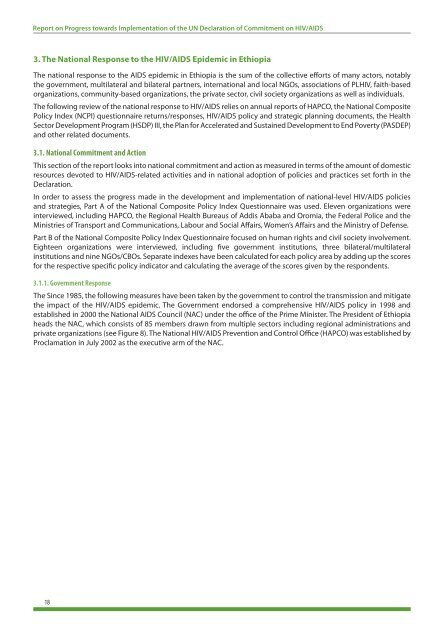Ethiopia - Country Progress Report - unaids
Ethiopia - Country Progress Report - unaids
Ethiopia - Country Progress Report - unaids
You also want an ePaper? Increase the reach of your titles
YUMPU automatically turns print PDFs into web optimized ePapers that Google loves.
<strong>Report</strong> on <strong>Progress</strong> towards Implementation of the UN Declaration of Commitment on HIV/AIDS<br />
3. The National Response to the HIV/AIDS Epidemic in <strong>Ethiopia</strong><br />
The national response to the AIDS epidemic in <strong>Ethiopia</strong> is the sum of the collective efforts of many actors, notably<br />
the government, multilateral and bilateral partners, international and local NGOs, associations of PLHIV, faith-based<br />
organizations, community-based organizations, the private sector, civil society organizations as well as individuals.<br />
The following review of the national response to HIV/AIDS relies on annual reports of HAPCO, the National Composite<br />
Policy Index (NCPI) questionnaire returns/responses, HIV/AIDS policy and strategic planning documents, the Health<br />
Sector Development Program (HSDP) III, the Plan for Accelerated and Sustained Development to End Poverty (PASDEP)<br />
and other related documents.<br />
3.1. National Commitment and Action<br />
This section of the report looks into national commitment and action as measured in terms of the amount of domestic<br />
resources devoted to HIV/AIDS-related activities and in national adoption of policies and practices set forth in the<br />
Declaration.<br />
In order to assess the progress made in the development and implementation of national-level HIV/AIDS policies<br />
and strategies, Part A of the National Composite Policy Index Questionnaire was used. Eleven organizations were<br />
interviewed, including HAPCO, the Regional Health Bureaus of Addis Ababa and Oromia, the Federal Police and the<br />
Ministries of Transport and Communications, Labour and Social Affairs, Women’s Affairs and the Ministry of Defense.<br />
Part B of the National Composite Policy Index Questionnaire focused on human rights and civil society involvement.<br />
Eighteen organizations were interviewed, including five government institutions, three bilateral/multilateral<br />
institutions and nine NGOs/CBOs. Separate indexes have been calculated for each policy area by adding up the scores<br />
for the respective specific policy indicator and calculating the average of the scores given by the respondents.<br />
3.1.1. Government Response<br />
The Since 1985, the following measures have been taken by the government to control the transmission and mitigate<br />
the impact of the HIV/AIDS epidemic. The Government endorsed a comprehensive HIV/AIDS policy in 1998 and<br />
established in 2000 the National AIDS Council (NAC) under the office of the Prime Minister. The President of <strong>Ethiopia</strong><br />
heads the NAC, which consists of 85 members drawn from multiple sectors including regional administrations and<br />
private organizations (see Figure 8). The National HIV/AIDS Prevention and Control Office (HAPCO) was established by<br />
Proclamation in July 2002 as the executive arm of the NAC.<br />
18

















